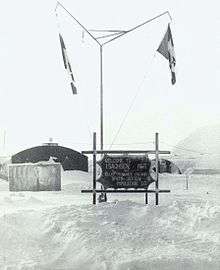Isachsen
Coordinates: 78°46′59″N 103°29′59″W / 78.78306°N 103.49972°W

Isachsen is a remote Arctic research-weather station named after the Norwegian explorer of the Arctic, Gunnar Isachsen. It is located on the western shore of Ellef Ringnes Island in the Sverdrup Islands, in the territory of Nunavut in Canada. Isachsen Station was established to participate in a joint Canadian-American weather observation program. Isachsen Station operated from April 3, 1948 through September 19, 1978. Regular weather observations began on May 3, 1948. In October 1949, a Douglas C-47 Skytrain (tail number 316062) crash landed near the station. No one was injured, but the wreckage has been preserved by the cold weather and dry conditions.
Climate
According to the Environment Canada Climate Severity Index, Isachsen and the surrounding area has the worst weather in Canada with a CSI severity value of 99 out of a possible 100.[1]
Flora and fauna
There are neither trees nor shrubs that can live this far north. The plant life here is limited to small patches of moss, lichens, and a few tiny flowering plants. The wildlife here is limited to polar bears, Arctic foxes, caribou, hares, lemmings, seals, muskoxen, and migratory birds.
History and background
On October 9, 1949, a U.S. Air Force C-47 cargo plane crashed on takeoff at the weather station. The plane had ten people on board: a U.S. Air Force crew of six and four civilian passengers. The passengers were two U.S. weather bureau employees, a Canadian weather bureau employee, and an RCMP constable. Three of the aircrew received cuts and bruises and everyone else escaped injury. The subsequent investigation blamed the accident on the plane being overloaded and attempting to take off with ice building up on the cockpit windshield and wings. At the time of the crash, there were five inches of snow on the mud runway, a light snowfall and some fog.[2] The wreck was briefly shown in an episode of the BBC program Top Gear. Photos of the remains of Isachsen Station can be seen on the Hilux Arctic Challenge Web site,[3] taken by the Top Gear team on their trip to the nearby 1996 North Magnetic Pole. The footage of the wreck was filmed on May 2, 2007. The episode first aired on July 25, 2007.[4]
During the 1950s, Isachsen Station was primarily collecting radiosonde observations. Along with weather soundings from similar stations such as Mould Bay, Eureka, and Alert, this information was used to complete the North American data, primarily used to produce weather forecasts over the North Atlantic Ocean, Greenland, and Iceland, and long-range weather forecasts for Western Europe.
The Isachsen Station was located in an extremely isolated place, with supplies and new personnel flown in by the Royal Canadian Air Force, usually twice a year: in the late spring, and again in the early fall from an air base at Resolute on Cornwallis Island. In turn, Resolute Station, like most northern communities, was supplied using ocean-going cargo ships aided by icebreakers during the late summer sealift.
The eight-man staff at Isachsen usually consisted of four Americans and four Canadians. The Americans were usually two weather observers, a cook, and a mechanic. The Canadians were usually two weather observers and two radio operators. All communication to and from Isachsen Station was via shortwave radio radiotelegraphy.
Fuel oil and diesel fuel for heating and cooking, and for the station's electric generators, respectively, were shipped to Isachsen by transport planes in standard metal fuel barrels.
During the summer of 1958, the Isachsen station was rebuilt using prefabricated buildings that had been airlifted in along with about a dozen construction personnel. The sun sets in October and it is totally dark for about three months with temperatures from −25 °F to −60 °F (-32 °C to -51 °C). In the summer, the sun is visible above the horizon 24 hours a day for about three months with temperatures from about 45 °F to 60 °F (7 °C to 16 °C).
In 1956, a plan by the Government of Canada to resettle the Inuit people at several high Arctic locations was scrapped. These settlements would have included Isachsen, Alert, Eureka, and Mould Bay.
On October 31, 1971, the United States withdrew from participation in the weather program at the site. In 1971, the Canadian government made a significant investment in Isachsen to upgrade its buildings. Then, in 1978, as a cost-cutting measure, the government decided to close one high Arctic station; Isachsen Station was selected, and it was closed down during that same year. The last manned weather observations were taken on July 31, 1978. An Automated Surface Observing System was placed at the site in 1989, linked by satellite communications to southern Canada. Isachsen is now uninhabited.
During the summers of 1989 and 1992, the closed weather station at Isachsen was the site of the High Arctic Psychology Research Station. The HAPRS operated under the aegis of the Polar Psychology Project, an international and transpolar multi-year program. Each time, 6 or 7 researchers used each other as participants in investigations of the effects of isolation, remoteness, and cold on psychological and physiological processes such as taste perception, irritability, mood, subjective and hormonal measures of stress, brain waves, and sleep patterns. In 1992, a survey was made of abandoned vehicles, fuel drums, and potential contaminants to assist Environment Canada in planning to remove such items from the site.
Photos of the station
Recent Photo Of Abandoned Isachsen Weather Station.
References
- ↑ David Phillips. "Climate Severity". The Canadian Encyclopedia.
- ↑ The Crashed U.S. Air Force Plane at Isachsen, oldwings.nl.
- ↑ "Hilux Arctic Challenge". Toyota.
- ↑ Arctic C-47 Wreck at Isachsen, Canada, oldwings.nl.
- Isachsen at the Atlas of Canada